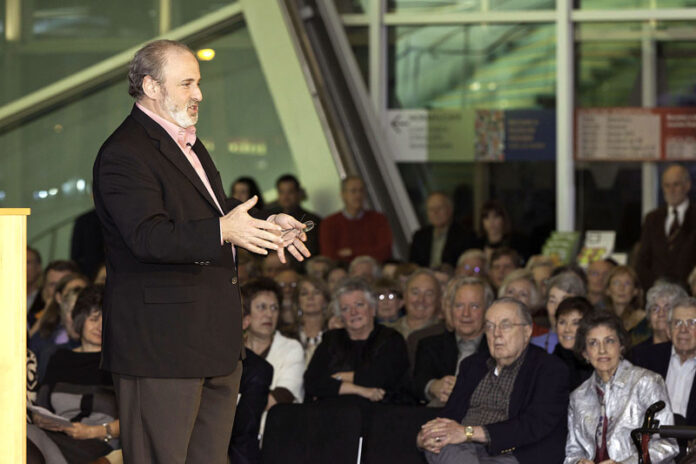After spending a year wrapping his arms around the problem of how to keep the Taubman Museum of Art afloat, Executive Director David Micklenberg and Board of Trustee President Paul France greeted an overflow crowd in the spacious atrium of the museum last Thursday. Taubman Museum members were invited to the town hall meeting – an exercise that Micklenberg vowed would be repeated within the next six months.
Artists, executives from other cultural institutions, Roanoke Mayor David Bowers and City Manager Chris Morrill were also in the audience. The city provided $6 million of the original $66 million price tag for the museum, with the remainder coming from mostly private funds.
“[This is] an opportunity to have a dialogue,” said France, who acknowledged that the Taubman’s board had “carried us through a very difficult time. It’s no secret that this has been a very difficult and trying year financially.”
“The sluggish economy has affected all arts organizations in Roanoke, added France, “not just the Taubman, which has retired most of its construction ($66 million) debt.”
The issue now is maintaining an annual operating budget that Micklenburg has trimmed from almost $4 million to around $2.6 million. Over the past two years the number of full time employees at the Taubman has been whittled down from more than 50 to less than two dozen.
“In retrospect, building a $45 million museum and earmarking the other $20 million raised for an endowment that could have funded operations, might have been a better idea before a recession,” said Micklenberg, “but that’s not the reality facing the Taubman.”
The earlier operating plan projected “an unrealistic financial model,” according to Micklenberg, with an excessive focus on constructing and paying for the controversial building, while too little was allocated for the programs and exhibits there. As for the outside building design, which still rubs some the wrong way: “Let’s get over it.”
France said of Micklenberg that, “I don’t really think he knew what was waiting for him.” The new executive director has worked “tirelessly,” to build better bridges to other arts organizations and artists, as well as local schools and the community at large, according to France, who talked about a need “for a change of focus.”
“Look for more transparency,” said France, a term Micklenburg echoed after he took over at the podium. “The New Direction” was the title posted on a projection screen. There is no role model elsewhere for how the Taubman should operate according to Micklenberg, “[only] the community in which you live. Don’t look at how art museums operate in other cities,” he noted.
Admissions to the museum have trended downward since its opening, and the number of paying visitors “died,” when the city shut down the streets around the market building for the early stages of the renovation project there.
More than 200,000 have paid their way into the Taubman since its November 2008 opening, but paid attendance this year to date is around 17,000. “It’s still one of the best-attended museums in the south,” said Micklenberg, who wants the Taubman to be thought of more as “an arts center” for the community. He noted that an installation piece by Floyd artist Charlie Brouwer would go up in the atrium soon.
Micklenberg fielded questions from the audience and answered several that are frequently asked, such as: why is there no art from the collection on the first floor of the Taubman? That’s because the first floor lies in the flood plain and the museum’s insurance would be “canceled” said Micklenberg,
Micklenberg also announced the hiring of a half dozen local adjunct curators, who will overlook specific shows and provide a better link to the community; he talked about podcasts available at the front counter soon that will provide an audio tour of the museum’s collection and the lowering of the admission price in the near future. He also wants to grow the current membership numbers from 2800 to 6000, and challenged the Roanoke Valley at large to become partners.
“What are you going to do?” he asked an audience member who questioned the museum’s funding sources. Expanded corporate fundraising efforts are a must as well.
Micklenberg acknowledged that communications with the public “needs to be better” and within the next few months a person will be hired to focus on that role, as well as new personnel in development and membership. The museum website will soon be updated to make it more accessible and interactive.
Local artist John Wilson, who volunteers at the Taubman, felt a year ago that Micklenberg “[was] a good person to be in this job. Now I know he is the right person. He’s got the experience necessary to turn this museum from a perceived elitist organization to a community organization.” Wilson would also like to see more people become members of the museum as one way of getting involved.
“The future is a little bit unknown,” admitted Micklenberg, “but we get to make the future together … the need for this museum is preeminent.”


